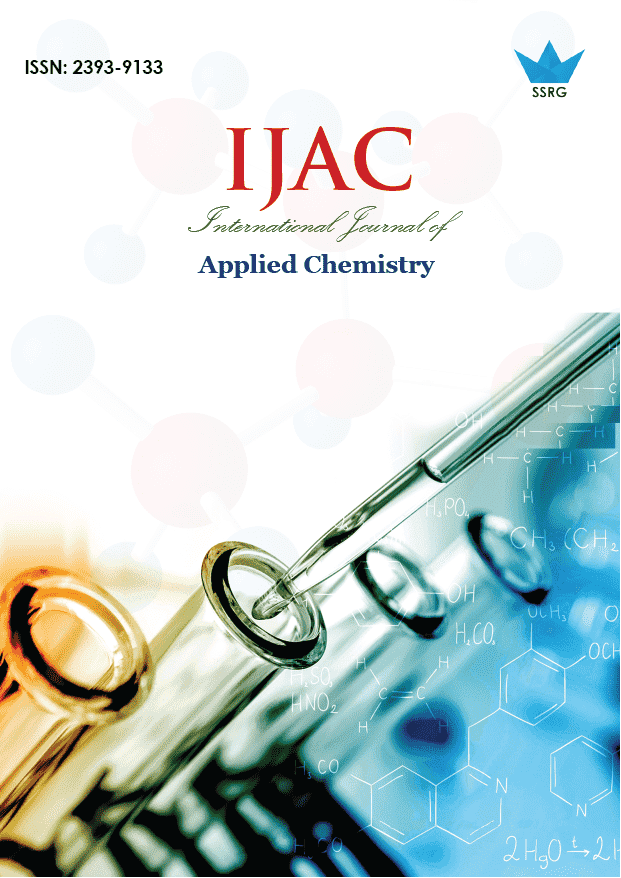Construction of a Hg2+-Sensitive Fluorescent Probe Derived from Rhodamine B

| International Journal of Applied Chemistry |
| © 2025 by SSRG - IJAC Journal |
| Volume 12 Issue 2 |
| Year of Publication : 2025 |
| Authors : Haoran Zhang, Yuqi Huang, Yuankai Liu, Jun Zhang |
How to Cite?
Haoran Zhang, Yuqi Huang, Yuankai Liu, Jun Zhang, "Construction of a Hg2+-Sensitive Fluorescent Probe Derived from Rhodamine B," SSRG International Journal of Applied Chemistry, vol. 12, no. 2, pp. 1-4, 2025. Crossref, https://doi.org/10.14445/23939133/IJAC-V12I2P101
Abstract:
A rhodamine B-based Hg2+-sensitive fluorescent probe P was characterized in H2O-EtOH solution (7:3, v:v, pH 7.0, 2 mM HEPES). Over other tested cations, only the addition of Hg2+ induced the opening of the spiral ring structure of P, and a fluorescence enhancement occurred at 595 nm with a naked eye observed color change from colorless to pink. Using Na2S as a complexing agent, the reversibility of the P-Hg2+ system was proved. The linear range of P for Hg2+ was 9.0×10-6-3.0×10-5 M with a detection limit of 3.0×10-6 M.
Keywords:
Rhodamine B, fluorescent probe, Hg2+, off-on, fluorescent enhancement.
References:
[1] Dihua Dai et al., “Recent Progress in Functional Materials for Selective Detection and Removal of Mercury (II) Ions,” Advanced Functional Materials, vol. 31, no. 1, 2021.
[CrossRef] [Google Scholar] [Publisher Link]
[2] Rita Ann Kampalath, and Jennifer Ayla Jay, “Sources of Mercury Exposure to Children in Low- and Middle-Income Country,” Journal of Health and Pollution, vol. 5, no. 8, pp. 33-51, 2015.
[CrossRef] [Google Scholar] [Publisher Link]
[3] Hugh H. Harris, Ingrid J. Pickering, and Graham N. George, “The Chemical Form of Mercury in Fish,” Science, vol. 301, pp. 1203-1203, 2003.
[CrossRef] [Google Scholar] [Publisher Link]
[4] Ksenia V. Ksenofontova et al., “Amine-Reactive BODIPY Dye: Spectral Properties and Application for Protein Labeling,” Molecules, vol. 27, no. 22, pp. 1-20, 2022.
[CrossRef] [Google Scholar] [Publisher Link]
[5] Riya Choudhary, and Sachin Kumar Srivastava, “Templating Assisted Fabrication of Flexible, Highly Stable and Uniform Plasmonic Platform for Ultrahigh Enhancement of Raman and Fluorescence Signals: Model Sensing of Rhodamine-6G,” Spectrochimica Acta Part A: Molecular and Biomolecular Spectroscopy, vol. 338, 2025.
[CrossRef] [Google Scholar] [Publisher Link]
[6] Virginie Dujols, Francis Ford, and Anthony W. Czarnik, “A Long-Wavelength Fuorescent Chemodosimeter Selective for Cu(II) Ion in Water,” Journal of the American Chemical Society, vol. 119, no. 31, pp. 7386-7387, 1997.
[CrossRef] [Google Scholar] [Publisher Link]
[7] Sung-Kyun Ko et al., “In Vivo Monitoring of Mercury Ions Using a Rhodamine-Based Molecular Probe,” Journal of the American Chemical Society, vol. 128, no. 43, pp. 14150-14155, 2006.
[CrossRef] [Google Scholar] [Publisher Link]
[8] Kyoung Nam Kim et al., “Rhodamine B Hydrazide Revisited: Chemodosimetric Hg2+-Selective Signaling Behavior in Aqueous Environments,” Bulletin-Korean Chemical Society, vol. 29, no. 3, pp. 571-574, 2008.
[CrossRef] [Google Scholar] [Publisher Link]
[9] Sheng Chen et al., “2-Hydroxy Benzothiazole Modified Rhodol: Aggregation-Induced Emission and Dual-Channel Fluorescence Sensing of Hg2+ and Ag+ ions,” Sensors and Actuators B: Chemical, vol. 255, no. 2, pp. 2086-2094, 2018.
[CrossRef] [Google Scholar] [Publisher Link]
[10] S.X. Chen, “The Design, Synthesis and Application of New Rhodamine-Based Fluorescent Probe,” M.E. Thesis, Zhejiang Sci-Tech University, Zhejiang, China, 2020.
[Publisher Link]

 10.14445/23939133/IJAC-V12I2P101
10.14445/23939133/IJAC-V12I2P101